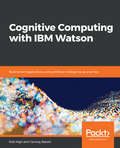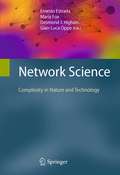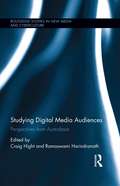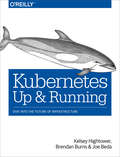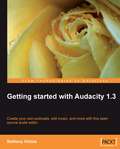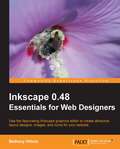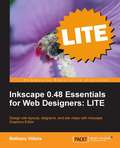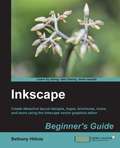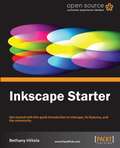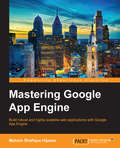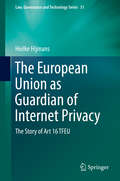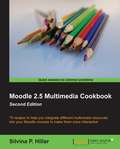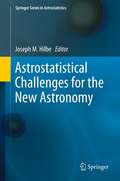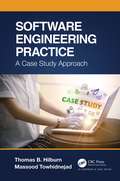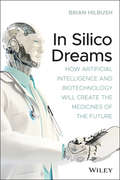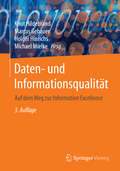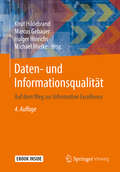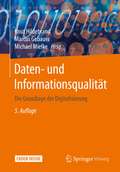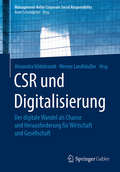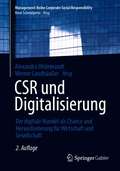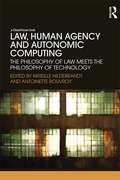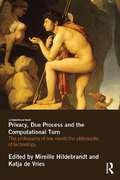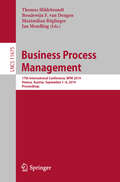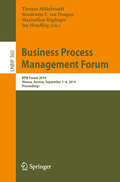- Table View
- List View
Cognitive Computing with IBM Watson: Build smart applications using artificial intelligence as a service
by Rob High Tanmay BakshiUnderstand, design, and create cognitive applications using Watson’s suite of APIs.Key FeaturesDevelop your skills and work with IBM Watson APIs to build efficient and powerful cognitive appsLearn how to build smart apps to carry out different sets of activities using real-world use casesGet well versed with the best practices of IBM Watson and implement them in your daily workBook DescriptionCognitive computing is rapidly infusing every aspect of our lives riding on three important fields: data science, machine learning (ML), and artificial intelligence (AI). It allows computing systems to learn and keep on improving as the amount of data in the system grows.This book introduces readers to a whole new paradigm of computing – a paradigm that is totally different from the conventional computing of the Information Age. You will learn the concepts of ML, deep learning (DL), neural networks, and AI through the set of APIs provided by IBM Watson. This book will help you build your own applications to understand, plan, and solve problems, and analyze them as per your needs. You will learn about various domains of cognitive computing, such as NLP, voice processing, computer vision, emotion analytics, and conversational systems, using different IBM Watson APIs.From this, the reader will learn what ML is, and what goes on in the background to make computers "do their magic," as well as where these concepts have been applied. Having achieved this, the readers will then be able to embark on their journey of learning, researching, and applying the concept in their respective fields.What you will learnGet well versed with the APIs provided by IBM Watson on IBM CloudLearn ML, AI, cognitive computing, and neural network principlesImplement smart applications in fields such as healthcare, entertainment, security, and moreUnderstand unstructured content using cognitive metadata with the help of Natural Language UnderstandingUse Watson’s APIs to create real-life applications to realize their capabilitiesDelve into various domains of cognitive computing, such as media analytics, embedded deep learning, computer vision, and moreWho this book is forThis book is for beginners and novices; having some knowledge about artificial intelligence and deep learning is an advantage, but not a prerequisite to benefit from this book. We explain the concept of deep learning and artificial intelligence through the set of tools IBM Watson provides.
Network Science
by Desmond J. Higham Gian-Luca Oppo Ernesto Estrada Maria FoxNetwork Science is the emerging field concerned with the study of large, realistic networks. This interdisciplinary endeavor, focusing on the patterns of interactions that arise between individual components of natural and engineered systems, has been applied to data sets from activities as diverse as high-throughput biological experiments, online trading information, smart-meter utility supplies, and pervasive telecommunications and surveillance technologies. This unique text/reference provides a fascinating insight into the state of the art in network science, highlighting the commonality across very different areas of application and the ways in which each area can be advanced by injecting ideas and techniques from another. The book includes contributions from an international selection of experts, providing viewpoints from a broad range of disciplines. It emphasizes networks that arise in nature--such as food webs, protein interactions, gene expression, and neural connections--and in technology--such as finance, airline transport, urban development and global trade. Topics and Features: begins with a clear overview chapter to introduce this interdisciplinary field; discusses the classic network science of fixed connectivity structures, including empirical studies, mathematical models and computational algorithms; examines time-dependent processes that take place over networks, covering topics such as synchronisation, and message passing algorithms; investigates time-evolving networks, such as the World Wide Web and shifts in topological properties (connectivity, spectrum, percolation); explores applications of complex networks in the physical and engineering sciences, looking ahead to new developments in the field. Researchers and professionals from disciplines as varied as computer science, mathematics, engineering, physics, chemistry, biology, ecology, neuroscience, epidemiology, and the social sciences will all benefit from this topical and broad overview of current activities and grand challenges in the unfolding field of network science.
Studying Digital Media Audiences: Perspectives from Australasia (Routledge Studies in New Media and Cyberculture)
by Craig Hight Ramaswami HarindranathAlthough many digital platforms continue to appropriate and reconfigure familiar forms of media experience, this is an environment which no longer consistently constructs an identifiable 'mass' audience in the terms understood by twentieth century audience researchers. The notion of 'audiencing' takes on different characteristics within a digital environment where platforms encourage users to upload, share and respond to content, while the platforms themselves monetise the digital traces of this activity. This environment demands new ways of thinking about audience and user engagement with media technologies, and raises significant questions on methods of conceiving and researching audience-users. This volume addresses ongoing debates in the field of audience research by exploring relevant conceptual and methodological issues concerning the systematic study of digital audiences. Drawing from work conducted by researchers based in Australia and New Zealand, the book uses theoretical frameworks and case study material which are of direct relevance to audience researchers globally.
Kubernetes: Dive into the Future of Infrastructure
by Kelsey Hightower Brendan Burns Joe BedaLegend has it that Google deploys over two billion application containers a week. How’s that possible? Google revealed the secret through a project called Kubernetes, an open source cluster orchestrator (based on its internal Borg system) that radically simplifies the task of building, deploying, and maintaining scalable distributed systems in the cloud. This practical guide shows you how Kubernetes and container technology can help you achieve new levels of velocity, agility, reliability, and efficiency.Authors Kelsey Hightower, Brendan Burns, and Joe Beda—who’ve worked on Kubernetes at Google and other organizatons—explain how this system fits into the lifecycle of a distributed application. You will learn how to use tools and APIs to automate scalable distributed systems, whether it is for online services, machine-learning applications, or a cluster of Raspberry Pi computers.Explore the distributed system challenges that Kubernetes addressesDive into containerized application development, using containers such as DockerCreate and run containers on Kubernetes, using the docker image format and container runtimeExplore specialized objects essential for running applications in productionReliably roll out new software versions without downtime or errorsGet examples of how to develop and deploy real-world applications in Kubernetes
Getting started with Audacity 1.3
by Bethany HiitolaConversational and practical, this book is full of real life examples of where and how you would use the Audacity software. Not only does it give you task-based step-by-step instructions from installation to advanced audio editing techniques, it caters to the beginner to familiarize them with all the jargon, suggests recording equipment, it walks them through a simple sample project showing off everything Audacity can do. If you are new to audio recording and editing, and particularly using the Audacity software, this book is for you. It explains everything from common audio industry terms and software basics. Technical sound engineering details and jargon are omitted to keep the book friendly and easy to understand.
Inkscape 0.48 Essentials for Web Designers
by Bethany HiitolaThis book is written in a clear conversational style, which emphasizes a practical learn-by-doing approach. Packed with illustrations and examples, this book will make the task of using Inkscape simple and straightforward.This book is written for web designers who want to add attractive visual elements to their website. It assumes no previous knowledge of Inkscape. General familiarity with vector graphics programming is recommended but not required. It will also be a useful guide for experienced Inkscape users who want to learn how to apply their skills to website design.
Inkscape 0.48 Essentials for Web Designers: LITE
by Bethany HiitolaThis book is written in a clear conversational style, which emphasizes a practical learn-by-doing approach. Packed with illustrations and examples, this book will make the task of using Inkscape simple and straightforward. This book is written for web designers who want to add attractive visual elements to their website. It assumes no previous knowledge of Inkscape. General familiarity with vector graphics programming is recommended but not required. It will also be a useful guide for experienced Inkscape users who want to learn how to apply their skills to website design.
Inkscape Beginner’s Guide
by Bethany HiitolaAs part of Packt's Beginner's Guide series, each chapter covers an aspect of working with Inkscape, with plenty of screenshots and practical examples. This book is intended for beginning graphic and web designers who want to expand their graphic software expertise. General familiarity with a graphics program is recommended, but not required.
Inkscape Starter
by Bethany HiitolaA short, simple guide with everything you need to get started, The quickest way to become productive, Learn about the main features and how to use them, Get to know the community and where to get help. If you are new to Inkscape this guide is the perfect companion for getting you off to a flying start. No previous experience with Inkscape is required as you will be walked through downloading Inkscape and installing it on your system. Become productive straightaway as you create your very first vector graphic. The list of resources in this guide will familiarize you with the Inkscape community, which is a valuable part of any Open Source project. Finally, you will see how to use seven key features of Inkscape - including using paths and layers, combining shapes, creating and editing text tools, importing and embedding images, and a list of keyboard shortcuts for text styling - which will allow you to perform simple tasks to learn the basics and set off on your own.
Mastering Google App Engine
by Mohsin Shafique HijazeeBuild robust and highly scalable web applications with Google App Engine About This Book * Get an in-depth look at how Google App Engine works under the hood * Design and model your application around Google's highly scalable distributed NoSQL datastore to unlock its full potential * A comprehensive guide to ensure your mastery of Google App Engine Who This Book Is For If you have been developing web applications in Python or any other dynamic language but have always wondered how to write highly scalable web applications without getting into system administration and other plumbing, then this is the book for you. No experience in writing scalable applications is required. What You Will Learn * Scale and develop your applications with Google App Engine's runtime environment * Get to grips with request handling mechanism and write request handlers * Deep dive into Google's distributed NoSQL and highly scalable datastore and design your application around it * Implement powerful search with scalable datastore * Perform long-running tasks in the background using task queues * Write compartmentalized apps using multi tenancy, memcache, and other Google App Engine runtime services * Handle web requests using the CGI, WSGI, and multi-threaded configurations * Deploy, tweak, and manage apps in production on Google App Engine In Detail Developing web applications that serve millions of users is no easy task, as it involves a number of configurations and administrative tasks for the underlying software and hardware stack. This whole configuration requires not only expertise, but also a fair amount of time as well. Time that could have been spent on actual application functionality. Google App Engine allows you develop highly scalable web applications or backends for mobile applications without worrying about the system administration plumbing or hardware provisioning issues. Just focus writing on your business logic, the meat of the application, and let Google's powerful infrastructure scale it to thousands of requests per second and millions of users without any effort on your part. This book takes you from explaining how scalable applications work to designing and developing robust scalable web applications of your own, utilizing services available on Google App Engine. Starting with a walkthrough of scalability is and how scalable web applications work, this book introduces you to the environment under which your applications exist on Google App Engine. Next, you will learn about Google's datastore, which is a massively scalable distributed NoSQL solution built on top of BigTable. You will examine the BigTable concepts and operations in detail and reveal how it is used to build Google datastore. Armed with this knowledge, you will then advance towards how to best model your data and query that along with transactions. To augment the powerful distributed dataset, you will deep dive into search functionality offered on Google App Engine. With the search and storage sorted out, you will get a look into performing long running tasks in the background using Google App Engine task queues along with sending and receiving emails. You will also examine the memcache to boost web application performance, image processing for common image manipulation tasks. You will then explore uploading, storing, and serving large files using Blobstore and Cloud storage. Finally, you will be presented with the deployment and monitoring of your applications in production along with a detailed look at dividing applications into different working modules. Style and approach This book is an in-depth guide where you will examine the problems in the context of highly scalable web applications. This book will take you through the libraries, services, and required configuration and finally puts everything together into a small web application that showcases all the capabilities of Google App Engine.
The European Union as Guardian of Internet Privacy
by Hielke HijmansThis book examines the role of the EU in ensuring privacy and data protection on the internet. It describes and demonstrates the importance of privacy and data protection for our democracies and how the enjoyment of these rights is challenged by, particularly, big data and mass surveillance. The book takes the perspective of the EU mandate under Article 16 TFEU. It analyses the contributions of the specific actors and roles within the EU framework: the judiciary, the EU legislator, the independent supervisory authorities, the cooperation mechanisms of these authorities, as well as the EU as actor in the external domain. Article 16 TFEU enables the Court of the Justice of the EU to play its role as constitutional court and to set high standards for fundamental rights protection. It obliges the European Parliament and the Council to lay down legislation that encompasses all processing of personal data. It confirms control by independent supervisory authorities as an essential element of data protection and it gives the EU a strong mandate to act in the global arena. The analysis shows that EU powers can be successfully used in a legitimate and effective manner and that this subject could be a success story for the EU, in times of widespread euroskepsis. It demonstrates that the Member States remain important players in ensuring privacy and data protection. In order to be a success story, the key stakeholders should be prepared to go the extra mile, so it is argued in the book. The book is based on academic research for which the author received a double doctorate at the University of Amsterdam and the Vrije Universiteit Brussels. It builds on a long inside experience within the European institutions, as well as within the community of data protection and data protection authorities. It is a must read in a time where the setting of EU privacy and data protection is changing dramatically, not only as a result of the rapidly evolving information society, but also because of important legal developments such as the entry into force of the General Data Protection Regulation. This book will appeal to all those who are in some way involved in making this regulation work. It will also appeal to people interested in the institutional framework of the European Union and in the role of the Union of promoting fundamental rights, also in the wider world.
Moodle 2.5 Multimedia Cookbook - Second Edition
by Silvina P. HilarWith practical examples presented in the style of recipes, this book is designed for you to be able to dip in and out as you need, only using the multimedia options that you want at the time.This cookbook is designed specifically for teachers who want to begin creating interactive and engaging Moodle courses by utilizing the multimedia capabilities of Moodle.
Astrostatistical Challenges for the New Astronomy (Springer Series in Astrostatistics #1)
by Joseph M. HilbeAstrostatistical Challenges for the New Astronomy presents a collection of monographs authored by several of the disciplines leading astrostatisticians, i.e. by researchers from the fields of statistics and astronomy-astrophysics, who work in the statistical analysis of astronomical and cosmological data. Eight of the ten monographs are enhancements of presentations given by the authors as invited or special topics in astrostatistics papers at the ISI World Statistics Congress (2011, Dublin, Ireland). The opening chapter, by the editor, was adapted from an invited seminar given at Los Alamos National Laboratory (2011) on the history and current state of the discipline; the second chapter by Thomas Loredo was adapted from his invited presentation at the Statistical Challenges in Modern Astronomy V conference (2011, Pennsylvania State University), presenting insights regarding frequentist and Bayesian methods of estimation in astrostatistical analysis. The remaining monographs are research papers discussing various topics in astrostatistics. The monographs provide the reader with an excellent overview of the current state astrostatistical research, and offer guidelines as to subjects of future research. Lead authors for each chapter respectively include Joseph M. Hilbe (Jet Propulsion Laboratory and Arizona State Univ); Thomas J. Loredo (Dept of Astronomy, Cornell Univ); Stefano Andreon (INAF-Osservatorio Astronomico di Brera, Italy); Martin Kunz ( Institute for Theoretical Physics, Univ of Geneva, Switz); Benjamin Wandel ( Institut d'Astrophysique de Paris, Univ Pierre et Marie Curie, France); Roberto Trotta (Astrophysics Group, Dept of Physics, Imperial College London, UK); Phillip Gregory (Dept of Astronomy, Univ of British Columbia, Canada); Marc Henrion (Dept of Mathematics, Imperial College, London, UK); Asis Kumar Chattopadhyay (Dept of Statistics, Univ of Calcutta, India); Marisa March (Astrophysics Group, Dept of Physics, Imperial College, London, UK).
Software Engineering Practice: A Case Study Approach (Chapman And Hall/crc Innovations In Software Engineering And Software Development Ser.)
by Thomas B. Hilburn Massood TowhidnejadThis book is a broad discussion covering the entire software development lifecycle. It uses a comprehensive case study to address each topic and features the following: A description of the development, by the fictional company Homeowner, of the DigitalHome (DH) System, a system with "smart" devices for controlling home lighting, temperature, humidity, small appliance power, and security A set of scenarios that provide a realistic framework for use of the DH System material Just-in-time training: each chapter includes mini tutorials introducing various software engineering topics that are discussed in that chapter and used in the case study A set of case study exercises that provide an opportunity to engage students in software development practice, either individually or in a team environment. Offering a new approach to learning about software engineering theory and practice, the text is specifically designed to: Support teaching software engineering, using a comprehensive case study covering the complete software development lifecycle Offer opportunities for students to actively learn about and engage in software engineering practice Provide a realistic environment to study a wide array of software engineering topics including agile development Software Engineering Practice: A Case Study Approach supports a student-centered, "active" learning style of teaching. The DH case study exercises provide a variety of opportunities for students to engage in realistic activities related to the theory and practice of software engineering. The text uses a fictitious team of software engineers to portray the nature of software engineering and to depict what actual engineers do when practicing software engineering. All the DH case study exercises can be used as team or group exercises in collaborative learning. Many of the exercises have specific goals related to team building and teaming skills. The text also can be used to support the professional development or certification of practicing software engineers. The case study exercises can be integrated with presentations in a workshop or short course for professionals.
In Silico Dreams: How Artificial Intelligence and Biotechnology Will Create the Medicines of the Future
by Brian S. HilbushLearn how AI and data science are upending the worlds of biology and medicine In Silico Dreams: How Artificial Intelligence and Biotechnology Will Create the Medicines of the Future delivers an illuminating and fresh perspective on the convergence of two powerful technologies: AI and biotech. Accomplished genomics expert, executive, and author Brian Hilbush offers readers a brilliant exploration of the most current work of pioneering tech giants and biotechnology startups who have already started disrupting healthcare. The book provides an in-depth understanding of the sources of innovation that are driving the shift in the pharmaceutical industry away from serendipitous therapeutic discovery and toward engineered medicines and curative therapies. In this fascinating book, you'll discover: An overview of the rise of data science methods and the paradigm shift in biology that led to the in silico revolution An outline of the fundamental breakthroughs in AI and deep learning and their applications across medicine A compelling argument for the notion that AI and biotechnology tools will rapidly accelerate the development of therapeutics A summary of innovative breakthroughs in biotechnology with a focus on gene editing and cell reprogramming technologies for therapeutic development A guide to the startup landscape in AI in medicine, revealing where investments are poised to shape the innovation base for the pharmaceutical industry Perfect for anyone with an interest in scientific topics and technology, In Silico Dreams also belongs on the bookshelves of decision-makers in a wide range of industries, including healthcare, technology, venture capital, and government.
Daten- und Informationsqualität: Auf dem Weg zur Information Excellence
by Knut Hildebrand Marcus Gebauer Holger Hinrichs Michael MielkeDas erste deutsche Buch zum Thema Daten- und Informationsqualität in der dritten, erweiterten Auflage. Wissenschaftlich fundiert und von Praktikern geschrieben, wird der aktuelle Stand aus Forschung und praktischer Anwendung präsentiert, in den wichtigen Facetten dieses wichtigen Themas. Ein Muss für alle IT-Profis.
Daten- und Informationsqualität: Auf dem Weg zur Information Excellence
by Knut Hildebrand Marcus Gebauer Holger Hinrichs Michael MielkeDie Verbesserung und Sicherung der Informationsqualität (IQ) wird in immer mehr Unternehmen als eigenständige und wichtige Managementaufgabe begriffen. IQ-Management ist mittlerweile ein elementarer Baustein in Systemintegrationsprojekten. Aber auch für laufende Prozesse mit heterogenen Daten und Nutzern ist eine hohe Informationsqualität die Grundvoraussetzung für funktionierende betriebliche Abläufe. Das erste deutschsprachige Buch zum Thema behandelt Daten- und Informationsqualität umfassend: von Definitionen zur Datenqualität über Methoden und Regelwerke für ihr Management bis hin zur Verankerung in der Organisation – mit Fallbeispielen aus zahlreichen Unternehmen. Im einführenden Kapitel erläutern die Autoren zunächst die Grundlagen. Sie stellen wissenschaftliche Modelle der Informationstheorie vor und erläutern die Rolle von Daten im Wissens- und Informationsmanagement und als Produktionsfaktor. Ein weiteres grundlegendes Kapitel widmet sich den verschiedenen Dimensionen der Informationsqualität. Anhand von 15 Begriffen und erläuternden Beispielen werden die IQ-Dimensionen wie beispielsweise Zugänglichkeit (accessibility), Umfang (appropriate amount of data) oder Glaubwürdigkeit (believability) präzise beschrieben. Dieses Kapitel ist zugleich Ergebnis der Arbeit einer Projektgruppe in der DGIQ (Deutsche Gesellschaft für Informations- und Datenqualität). Im zweiten Teil des Buchs werden die Methoden, Tools und Techniken für das Management der Datenqualität erläutert. Dazu zählen unter anderem Datenqualitätsmetriken, Methoden wie Total Data Quality Management, die strukturierte Datenanalyse oder Maßnahmen wie Datenbereinigung. Der Band wurde für die vierte Auflage erweitert und an zahlreichen Stellen überarbeitet. Wissenschaftlich fundiert und von Praktikern geschrieben, präsentiert es den aktuellen Stand aus Forschung und Anwendung. Das Buch richtet sich an Unternehmensführungen, IT-Manager, beispielsweise in Banken und Versicherungen, und an alle Datenspezialisten. Ein Muss für alle IT-Profis.
Daten- und Informationsqualität: Die Grundlage der Digitalisierung
by Knut Hildebrand Marcus Gebauer Michael MielkeDieses Buch war das erste deutsche Buch zum Thema Daten- und Informationsqualität und ist mittlerweile ein Klassiker. Es wurde für die fünfte Auflage um neue Inhalte erweitert, aktualisiert und an zahlreichen Stellen überarbeitet. Von Wissenschaftlern und Praktikern geschrieben, präsentiert es den aktuellen Stand aus Forschung und Anwendung und ist somit ein Muss für alle IT-Profis.
CSR und Digitalisierung: Der digitale Wandel als Chance und Herausforderung für Wirtschaft und Gesellschaft (Management-Reihe Corporate Social Responsibility)
by Alexandra Hildebrandt Werner LandhäußerDieses Buch ist ein Kaleidoskop unserer Gesellschaft und Zeit. Es besch#65533;ftigt sich mit Herausforderungen, Chancen und Risiken der gr#65533;#65533;ten Transformation der Geschichte: der Digitalisierung. Vorgestellt werden bahnbrechende neue Methoden zur nachhaltigen Steuerung der digitalen Transformation, neue Denkstile sowie neue Formen interdisziplin#65533;rer Zusammenarbeit - etwa mit Geistes-, Sozial- und Naturwissenschaftlern, #65533;konomen, Informatikern, Psychologen, Philosophen und Vertretern der Kreativwirtschaft. Sie zeigen, dass Digitalisierung weder gef#65533;rchtet noch verehrt werden muss, denn es geht vor allem darum, ihre Rolle zu verstehen, um sie nachhaltig zu gestalten.
CSR und Digitalisierung: Der digitale Wandel als Chance und Herausforderung für Wirtschaft und Gesellschaft (Management-Reihe Corporate Social Responsibility)
by Alexandra Hildebrandt Werner LandhäußerIn der 2. Auflage des Buches "CSR und Digitalisierung" werden zwei Jahrhundertthemen zusammengeführt, die die wichtigsten Fragen unserer Zeit bündelnWie können wir ökologisch und sozial verantwortlich wirtschaften?Welche Rolle kann und soll die Digitalisierung dabei spielen? Die Digitalagenda ist die erste Strategie in Europa, die Digitalisierung und Umweltschutz konsequent miteinander verbindetDas vorliegende Buch ist allerdings auch eine Erweiterung der hier angesprochenen Themen, denn viele der vorgeschlagenen Maßnahmen basieren auf „weichen“ Instrumenten. Gezeigt wird u. a., welche aktuellen Maßnahmen und Methoden zur nachhaltigen Steuerung der digitalen Transformation die besten Unternehmen und Organisationen einsetzen, aber auch, dass es heute neue Denkstile sowie neue Formen interdisziplinärer Zusammenarbeit braucht. Digitalisierung muss weder gefürchtet noch verehrt werden, denn es geht vor allem darum, ihre Rolle zu verstehen, um sie nachhaltig zu gestalten. Finden Sie Beiträge unter anderem von:Franz Alt, Wolfgang Schäuble, Judith Gerlach, Timotheus Höttges, Olaf Koch, Henning Kagermannm, Christian Seifert, Manuel Neukirchner, Jutta Rump
Information, Freedom and Property: The Philosophy of Law Meets the Philosophy of Technology
by Mireille Hildebrandt Bibi van den BergThis book addresses issues on the nexus of freedom of and property in information, while acknowledging that both hiding and exposing information may affect our privacy. It inquires into the physics, the technologies, the business models, the governmental strategies and last but not least the legal frameworks concerning access, organisation and control of information. It debates whether it is in the very nature of information to be either free or monopolized, or both. Analysing upcoming power structures, new types of colonization and attempts to replace legal norms with techno-nudging, this book also presents the idea of an infra-ethics capable of pre-empting our pre-emption. It discusses the interrelations between open access, the hacker ethos, the personal data economy, and freedom of information, highlighting the ephemeral but pivotal role played by information in a data-driven society. This book is a must-read for those working on the contemporary dimensions of freedom of information, data protection, and intellectual property rights.
Law, Human Agency and Autonomic Computing: The Philosophy of Law Meets the Philosophy of Technology
by Mireille Hildebrandt Antoinette RouvroyLaw, Human Agency and Autonomic Computing interrogates the legal implications of the notion and experience of human agency implied by the emerging paradigm of autonomic computing, and the socio-technical infrastructures it supports. The development of autonomic computing and ambient intelligence – self-governing systems – challenge traditional philosophical conceptions of human self-constitution and agency, with significant consequences for the theory and practice of constitutional self-government. Ideas of identity, subjectivity, agency, personhood, intentionality, and embodiment are all central to the functioning of modern legal systems. But once artificial entities become more autonomic, and less dependent on deliberate human intervention, criteria like agency, intentionality and self-determination, become too fragile to serve as defining criteria for human subjectivity, personality or identity, and for characterizing the processes through which individual citizens become moral and legal subjects. Are autonomic – yet artificial – systems shrinking the distance between (acting) subjects and (acted upon) objects? How ‘distinctively human’ will agency be in a world of autonomic computing? Or, alternatively, does autonomic computing merely disclose that we were never, in this sense, ‘human’ anyway? A dialogue between philosophers of technology and philosophers of law, this book addresses these questions, as it takes up the unprecedented opportunity that autonomic computing and ambient intelligence offer for a reassessment of the most basic concepts of law.
Privacy, Due Process and the Computational Turn: The Philosophy of Law Meets the Philosophy of Technology
by Mireille Hildebrandt Katja De VriesPrivacy, Due process and the Computational Turn: The Philosophy of Law Meets the Philosophy of Technology engages with the rapidly developing computational aspects of our world including data mining, behavioural advertising, iGovernment, profiling for intelligence, customer relationship management, smart search engines, personalized news feeds, and so on in order to consider their implications for the assumptions on which our legal framework has been built. The contributions to this volume focus on the issue of privacy, which is often equated with data privacy and data security, location privacy, anonymity, pseudonymity, unobservability, and unlinkability. Here, however, the extent to which predictive and other types of data analytics operate in ways that may or may not violate privacy is rigorously taken up, both technologically and legally, in order to open up new possibilities for considering, and contesting, how we are increasingly being correlated and categorizedin relationship with due process – the right to contest how the profiling systems are categorizing and deciding about us.
Business Process Management: 17th International Conference, BPM 2019, Vienna, Austria, September 1–6, 2019, Proceedings (Lecture Notes in Computer Science #11675)
by Thomas Hildebrandt Boudewijn F. van Dongen Maximilian Röglinger Jan MendlingThis book constitutes the proceedings of the 17th International Conference on Business Process Management, BPM 2019, held in Vienna, Austria, in September 2019. The 23 full and 4 tutorial short papers included in this volume were carefully reviewed and selected from 115 submissions. The papers were organized in topical sections named: foundations; engineering; and management.
Business Process Management Forum: BPM Forum 2019, Vienna, Austria, September 1–6, 2019, Proceedings (Lecture Notes in Business Information Processing #360)
by Thomas Hildebrandt Boudewijn F. van Dongen Maximilian Röglinger Jan MendlingThis book constitutes the proceedings of the BPM Forum held during the 17th International Conference on Business Process Management, BPM 2019, which took place in Vienna, Austria, in September 2019. The BPM Forum hosts innovative research which has a high potential of stimulating discussions. The papers selected for the forum are expected to showcase fresh ideas from exciting and emerging topics in BPM, even if they are not yet as mature as the regular papers at the conference. The 13 full papers included in this volume were carefully reviewed and selected from a total of 115 submissions. The papers were organized in topical sections named: specification; execution; analytics; and management.
